What on Earth do I do with This?

When I started having a regular ‘veg box’ delivery and shopping at local markets, through the seasons I gradually became aware of rather strange, alien-looking fruit and vegetables that I had never had the pleasure of cooking with before. Long-forgotten gnarled and knobbly favourites, such as quince and celeriac, reintroduced to the marketplace by innovative farmers. Thank goodness for the recipe cards included in the veg box and the helpful advice from enthusiastic market stall holders, who always have a wealth of knowledge and passion for the produce they grow. With a little research and a lot of chatting, I soon became a dab hand at getting the best from these traditional gems.
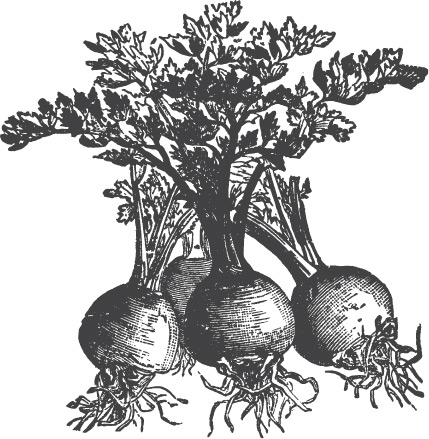
Celeriac might be the ugly duckling of the vegetable world, but this bulbous knobbly root, derived from the wild celery plant, is secretly a swan on the inside. Its white crunchy flesh, with a hint of celery flavour, becomes silky smooth when cooked. Enjoy raw in salads or roast in a hot oven with olive oil, thyme and chopped garlic. It is particularly good with fruit; simmer in stock with apples or pears, onion and potato to make an innovative soup, or boil and mash with apple chunks caramelized in butter.
One of its many attributes is a very long shelf life. Stored in a cool dark place it keeps for weeks. Returning from holiday it’s always a welcome sight in an otherwise empty fridge, a handy ingredient to rustle up a quick homecoming supper.
Cut away the roots, skin and any green shoots and, to avoid discoloration, immerse in cold water with a squeeze of lemon until ready to use.

CELERIAC, FENNEL AND APPLE REMOULADE
Celeriac is as common as the carrot in France and is sold raw in pre-cut matchstick shapes ready to make remoulade, a crunchy salad rather like coleslaw. Apple, fennel and capers are added to the classic recipe to make a remoulade with a contemporary twist. Serve with watercress and prosciutto or smoked fish.
1/2 medium celeriac (about 275g/10oz)
1 fennel bulb
1 tart apple
Dressing
4 heaped tablespoons good mayonnaise
1 heaped tablespoon Greek yoghurt
1 tablespoon olive oil juice of half a lemon
2 heaped tablespoons roughly chopped capers
a small handful of chopped flat-leaf parsley
salt and black pepper
Peel the celeriac, cut into matchstick shapes, and immerse in cold water with a splash of lemon juice until ready to use. Trim the fennel, cut in half lengthwise, remove the hard central core and thinly slice. Core the apple, cut it into matchsticks and add to the lemon water along with the celeriac.
Whisk the dressing ingredients together and season to taste.
Drain the celeriac and apple, pat dry with a clean tea towel and combine with the fennel. Toss with the dressing until well coated.

Celeriac adds a nutty flavour to this St Patrick’s Day favourite, traditionally made from potato mashed with spring onions and topped with butter.
1 medium celeriac, peeled and cubed
3 medium mashing potatoes, peeled and cubed
2 garlic cloves, peeled and quartered
110ml/1/2 cup whole milk
a bunch of spring onions, thinly sliced
a good knob of butter
1 heaped teaspoon grainy mustard
75ml/1/4 cup thick double cream or full-fat crème fraîche
a large handful of finely chopped curly parsley
salt and black pepper
To serve
extra butter, at room temperature
Simmer the prepared celeriac, potato and garlic in boiling water until soft. Drain the vegetables, return to the pan and steam dry over a low heat for a few minutes.
Heat the milk and sliced spring onions in a small pan until nearly boiling, reduce the heat and gently simmer for a further couple of minutes.
Add the milk mixture along with the butter and mustard to the drained celeriac and potato. Mash everything together until smooth. Stir in the cream and chopped parsley and season to taste.
To serve in the traditional way, pile the champ into a bowl, make an indent in the top with the back of a serving spoon and fill with a large knob of butter room temperature. Serve immediately as the butter melts.
Firm, full flavoured and juicy, gooseberries vary in sweetness depending on variety: as a general rule of thumb green tend to be sharper than red.
Popular for centuries in jams, pies, puddings and chutneys, gooseberries are now making a comeback. Tart gooseberry sauce makes a traditional accompaniment to mackerel or oily fish and nothing quite beats a deep filled gooseberry pie or crumble topped with thick creamy custard. Simmer gooseberries with equal quantities of apple and enough water to prevent sticking until the fruit starts to soften, sweeten to taste, pile into a pie dish, top with crumble, shortcrust or puff pastry, and bake in the oven until golden brown.
To prepare gooseberries, trim away any stalks and hairy tufts with a pair of kitchen scissors. Once prepared they require only a short cooking time.
The gooseberry fruiting season is short, but you can freeze prepared uncooked berries whole, to enjoy all year round.
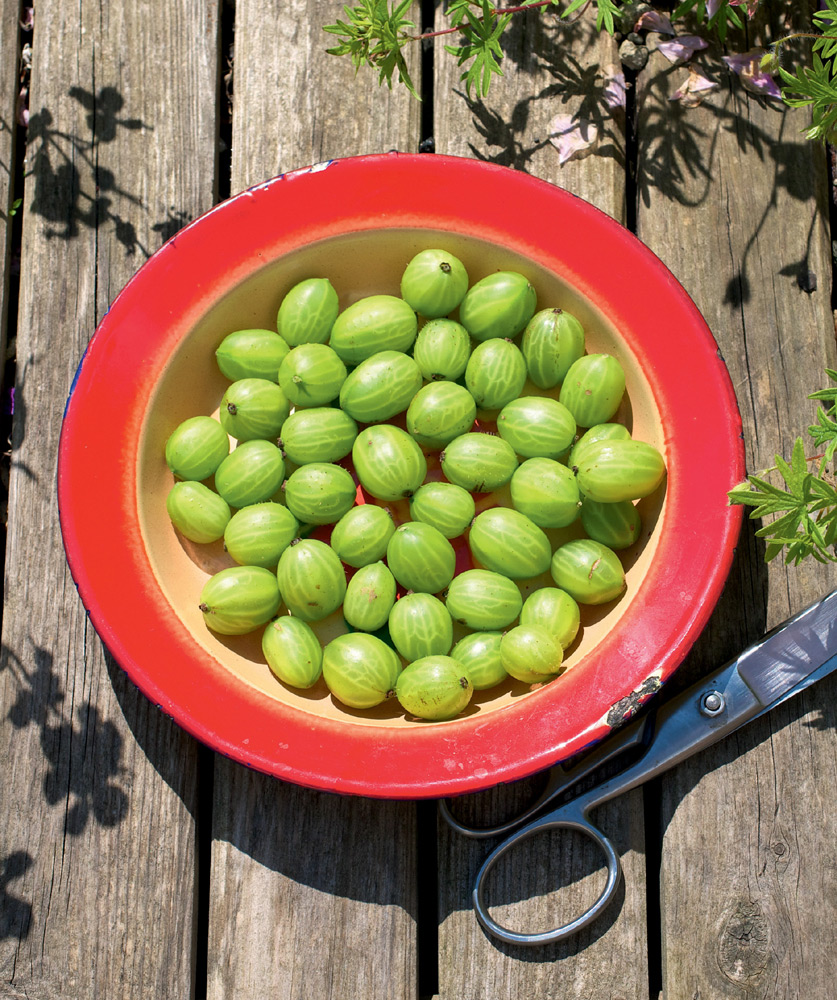
Traditionally served with mackerel, this tart sauce also works well with any oily fish or pork. Incidentally, it is just as good spooned on to thick yoghurt or porridge.
300g/10oz prepared gooseberries zest and juice of half an orange
a 4cm/1 1/2 inch piece of peeled and grated ginger root
1 tablespoon clear honey
a large knob of butter
Place all the ingredients in a saucepan and gently simmer, stirring at regular intervals, until the gooseberries are soft and start to break down.
GOOSEBERRY AND ELDERFLOWER FOOL
By happy chance gooseberries are ready to pick at the same time as elderflowers. Here is a classic example of ‘what grows together goes together’. Purists tie a handful of elderflowers in a muslin bag and simmer along with the berries (if using flowers you may need to add a little extra sugar). Alternatively, add a slug of homemade elderflower cordial.
450g/1lb prepared gooseberries
50-100g/1/4-/1/2 cup golden caster sugar (to taste)
4 tablespoons elderflower cordial
300ml/1 1/4 cups double cream
zest of a lime
To decorate
blueberries and mint leaves
Simmer the gooseberries and caster sugar with a tablespoon of water until soft, crushing the berries after a few minutes to encourage them to break down and release their juices. Stir in the elderflower cordial and leave to cool.
Whip the cream until it forms soft peaks. Fold in the cooled crushed gooseberries and lime zest.
Spoon the fool into teacups or glasses, cover with cling film and chill in the fridge for an hour or so. Decorate with blueberries and mint leaves before serving.
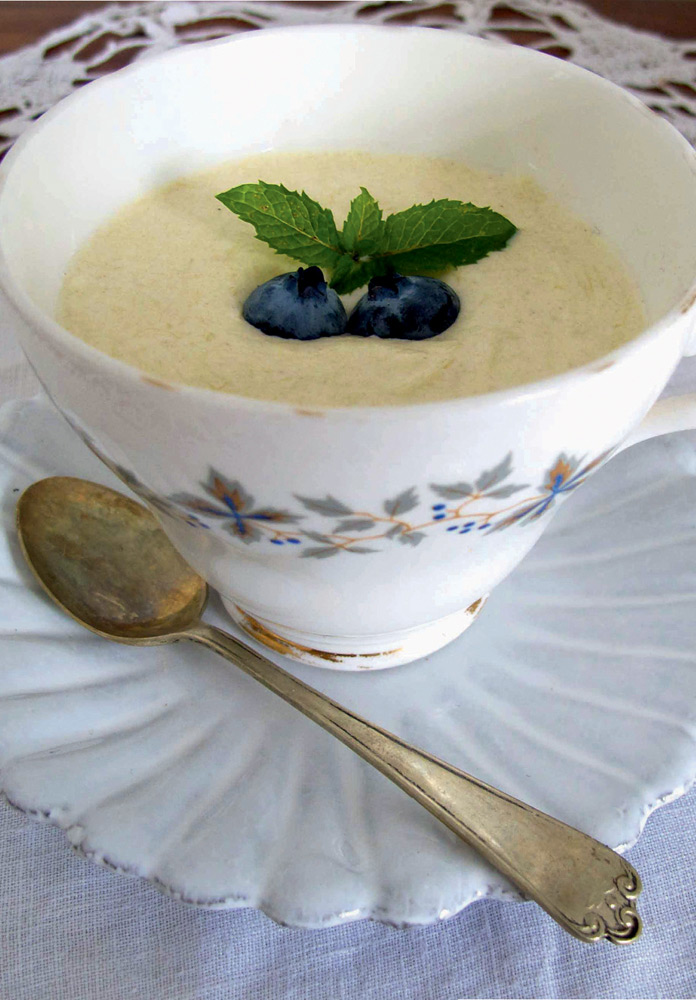
Serve a farmhouse Cheddar cheese ploughman’s with a dollop of this punchy gooseberry chutney, and you’ll never look back. The recipe also works well with rhubarb. Peel the stems, cut into chunks and follow the same method.
MAKES ABOUT 2 X 450G/1LB JARS
700g/1 1/2lb prepared gooseberries
1 red onion, finely chopped
1 dessertspoon finely chopped ginger root
110ml/1/2 cup water
225g/1 1/2 cups brown sugar
1/2 teaspoon salt
a large handful of raisins
1 flat teaspoon ground ginger
1 cinnamon stick or 1 teaspoon ground cinnamon
1/4 teaspoon cayenne pepper
1/2 teaspoon yellow mustard seeds
1/4 teaspoon crushed black pepper
240ml/1 cup cider vinegar
Simmer the gooseberries with the diced onion, chopped ginger and water until soft. Gently crush the gooseberries with the back of a wooden spoon.
Add the remaining ingredients and simmer briskly until the chutney has reduced to a jam-like consistency.
Remove the cinnamon stick and spoon the chutney into sterilized jars. Seal with a tight-fitting lid and store in a cool, dark place. The chutney can be eaten straight away but if you can wait it does improve with age.

Beetroot has achieved a revolution. No longer soaked in vinegar and served sliced with a limp lettuce leaf, it has seized its rightful place as a traditional home-grown staple, full of potent antioxidants and minerals. Look out for yellow, orange or pink-and-white-striped varieties.
Sweet and earthy, it is as delicious served raw as it is cooked, and combined with carrots and ginger root it makes a nutrient-packed juice.
Its culinary uses are endless: roast whole baby beets doused in olive oil until soft or layer wafer-thin beetroot slices with grated cheese and cream in a pastry case and bake until golden. Pair cooked beetroot with soft goat’s cheese, walnuts, pomegranate seeds and salad leaves or simply slice and serve with horseradish sauce and rocket leaves in a homemade burger.
Choose smallish roots, preferably with the leaves still attached. Don’t discard the leaves (beetroot was originally grown for its leaves), mix small tender leaves with salads or steam larger leaves and drizzle with oil.
A medium-sized beetroot takes about 30 minutes to cook in simmering water; trim the stalks away leaving the tapered root and skin intact – the skin easily peels away when cooked. Remember to wear rubber gloves when handling beetroot, if you want to avoid pink-stained hands.

BEETROOT LEAVES WITH WALNUTS, RAISINS AND ORANGE
Beetroot leaves are best used when they are very fresh. Like spinach, they shrink considerably once cooked. Chard or kale can also be used in the place of beetroot leaves.
SERVES 2
fresh leaves cut from a large bunch of beetroot
1 tablespoon olive oil
1 garlic clove, thinly sliced
1 hot red chilli, thinly sliced
2.5cm/1inch peeled ginger root
a handful of chopped walnuts
a handful of raisins
grated zest and juice of half an orange
salt and black pepper
soft goat’s cheese, to serve
Thoroughly wash the beetroot leaves (they can often be a bit muddy) and roughly slice.
Heat the oil in a large frying pan, add the garlic, chilli and ginger and stir-fry until soft.
Add the chopped walnuts and raisins and stir-fry until caramelized.
Add the prepared beetroot leaves, orange juice and zest and stir-fry until the leaves are soft.
Season to taste and serve dotted with soft goat’s cheese.
 BEETROOT BARLEY RISOTTO WITH HORSERADISH CREAM
BEETROOT BARLEY RISOTTO WITH HORSERADISH CREAM
Beetroot and nutty pearl barley are cooked together to make a healthy alternative to a traditional risotto.
3 medium raw beetroot
2 tablespoons olive oil
25g/1/4 stick butter
1 medium red onion, diced
3 garlic cloves, finely chopped
400g/2 cups pearl barley
110ml/1/2 cup dry white wine
2 bay leaves
1 litre/4 cups hot chicken or vegetable stock
75g/1 cup grated mature Manchego or Parmesan cheese
a large knob of butter
a handful of marjoram leaves, chopped
salt and black pepper
To serve
110ml/1/2 cup crème fraîche or sour cream
1 heaped dessertspoon hot horseradish
rocket leaves
extra grated Manchego or Parmesan cheese
Wearing rubber gloves, peel and medium-grate the beetroot.
In a heavy-bottomed pan heat the olive oil and butter. When the butter has melted, add the onion and garlic and sauté until soft but not brown.
Add the grated beetroot and the pearl barley and stir until coated in oil.
Pour in the wine and simmer, stirring constantly until absorbed.
Add the bay leaves and a ladle of hot stock and cook on a medium heat, stirring constantly until the stock has been absorbed. Continue adding the stock ladle by ladle, until the stock has been used up and the pearl barley is soft, adding extra stock if necessary.
Remove the bay leaves and stir in the cheese, butter, marjoram and seasoning to taste.
Season the crème fraîche and whisk in the hot horseradish. Spoon on to the risotto and top with grated cheese and rocket leaves.
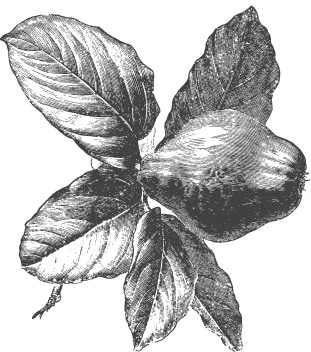
‘Quince! Help yourself’ read the sign on a bucket of unusual-looking pear-shaped fruit, outside a kindly neighbour’s house. So I did and after chatting with those in the know I set to. Soon my kitchen was filled with the floral scent of this wonderful ancient fruit.
A relative of the apple and pear tree, quince has a hard flesh with a slightly furry bloom on the skin. Most varieties are inedible when raw, but once cooked they become soft, dark pink and luscious with a perfumed flavour. Use a sturdy vegetable peeler to peel away the tough outer skin and once peeled drop into water with a squeeze of lemon to avoid discoloration. Prepared quince takes about 30 minutes to cook. Its firm flesh holds its shape well and it can easily be frozen for a later date.
Mix poached quince chunks with apples in a crumble or tarte tatin or purée together to make a fruity sauce. Add a pinch of cinnamon, star anise, nutmeg or clove to complement its delicate floral flavour. Poach with honey, cinnamon, grated fresh ginger root and orange zest or add to spiced savoury stews. The high pectin content of quince ensures an easy to set jam, jelly or fruit cheese.
Serve slices of this thick preserve with mature tangy cheese for a sweet-savoury taste combination. The recipe is for 1kg/2 1/4lb of quince – adjust the measurements depending on how much fruit you have available. If you can’t get hold of quince, apples mixed with blackberries make a good substitute; sieve the fruit before measuring the required amount of sugar. To make quince jam, replace the vanilla with the juice and rind of a lemon and briskly simmer the fruit and sugar together for a shorter length of time, until the mixture has the consistency of a jam and setting point is reached (see page 9).
MAKES ABOUT 1KG/2 1/4LB
1kg/2 1/4lb quince
150ml/ 2/3 cup water
sugar
1 vanilla pod, slit lengthwise
Peel the quince and immerse in a bowl of water with a squeeze of lemon until ready to use.
Medium-grate the quince flesh from the central core and place in a heavy-bottomed saucepan. Pour in the water, cover the pan and simmer until the fruit is soft and breaking down.
Allow the quince purée to cool a little, and then pour into a measuring jug. Calculate how much sugar to add based on the proportion of 450g/2 1/4 cups of sugar for every 600ml/2 1/2 cups of fruit.
Return the quince to the pan with the correct quantity of sugar and stir together over a low heat until all the sugar has dissolved. Scrape the seeds from the slit vanilla pod and add to the pan. Turn up the heat and simmer briskly, stirring regularly, until a thick, dark pink mixture forms. The cheese should be thick enough to leave a clean line when a spoon is drawn across the bottom of the pan.
Allow the quince to cool a little, spoon into medium-sized flat oblong plastic tubs (with a fitted lid) and level with the back of a spoon. When completely cool, cover the tubs and place in the fridge. Quince cheese is ready once it has fully set, although it does benefit from a little age. Stored in the fridge it will keep for weeks.
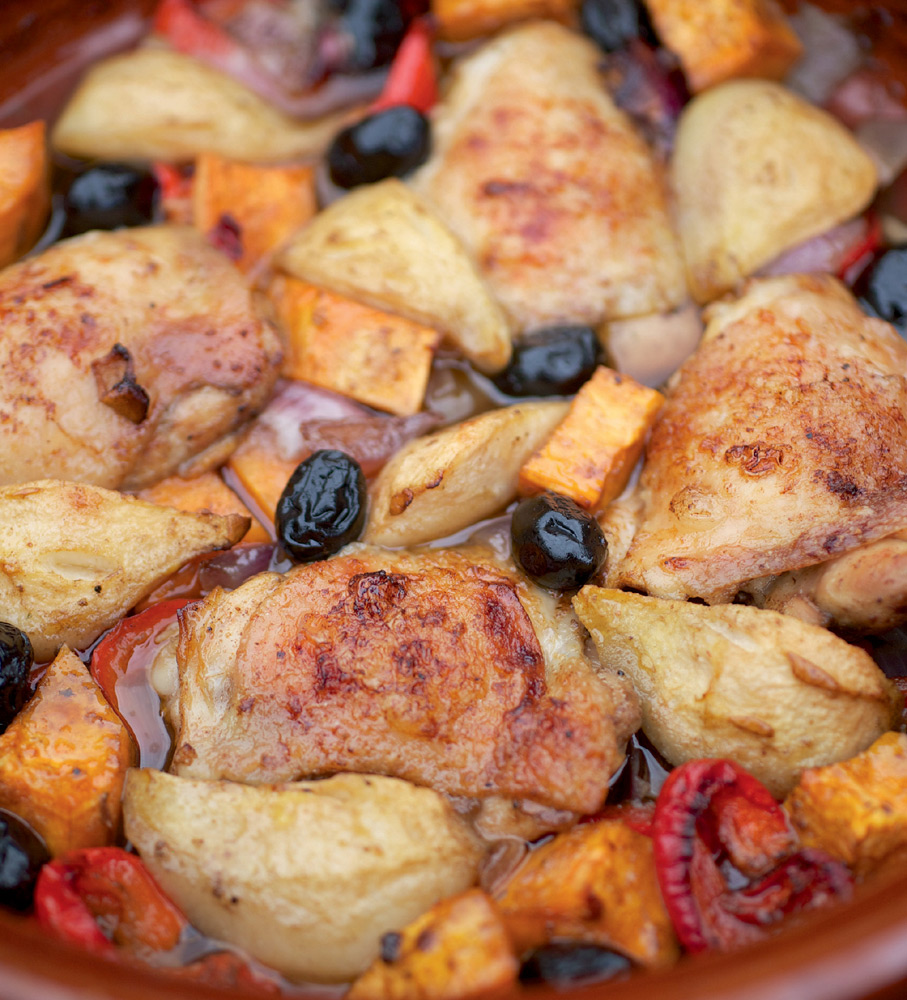
 SPICED CHICKEN CASSEROLE WITH QUINCE
SPICED CHICKEN CASSEROLE WITH QUINCE
A rich, aromatic spiced one-pot casserole, with the added subtle flavour of scented quince. To make life easy I always use a cast-iron stovetop-to-oven casserole dish. If you don’t have such a thing, just use a frying pan on top of the stove and transfer to a casserole dish before placing in the oven.
2 quince
1 medium sweet potato
1 red pepper
1/2 teaspoon black pepper
2 tablespoons olive oil
6 chicken thighs
1 large red onion, cut into chunks
2 crushed garlic cloves
1 teaspoon ground coriander
1 teaspoon ground cumin
1/2 teaspoon ground ginger
1/2 teaspoon ground cinnamon
a handful of black olives
chicken stock
salt
Preheat the oven to 190°C/375°F/gas mark 5.
Peel and core the quince and cut each one lengthwise into 6 pieces. Peel the sweet potato and cut into largish chunks. Cut the pepper in half, de-seed and cut into thickish strips.
Heat the olive oil in a stovetop-to-oven pan and brown the chicken thighs on all sides. Remove the chicken from the pan and set to one side. Add the onion and garlic to the same pan and sauté until just soft. Sprinkle in the spices and cook for a further minute, stirring constantly to prevent sticking.
Turn off the heat and return the chicken to the pan. Add the quince, vegetables and olives. Season with salt to taste and pour in enough stock to half cover the chicken. Cover the pan with a fitted lid or foil.
Place the casserole in the preheated oven for about 1 hour 10 minutes, removing the cover after 45 minutes and basting the vegetables and chicken with the sauce.

Love them or loathe them there is certainly more to the humble Brussels sprout than being boiled to death. Childhood memories of mushy dull green blobs leaking water on to a plate have given Brussels a bad reputation (a tasteless mass to skirt around and hide under a napkin). With a little age and wisdom I now view these attractive mini cabbages, full of vitamins and folic acid, as something rather special.
The first rule is never to overcook a Brussels sprout. The second is to eat them only when they are naturally in season; they taste sweeter after the first frost.
Serve Brussels sprouts with pride; sauté in butter and garlic or purée with cream and mustard. Baby sprouts are delicate enough to eat raw: finely shred, mix with pea sprouts and toasted pumpkin seeds and dress with a lemony vinaigrette. Older sprouts make a thick and warming winter soup; sauté with chopped onion, potato and chestnuts, cover with stock and simmer until soft. Season with nutmeg and liquidize with a splash of cream.

CREAMY BRUSSELS PURÉE WITH WALNUTS
I defy anyone not to enjoy this creamy, nutty dish served with crispy fried streaky bacon and caramelized onions.
600g/1lb 5oz Brussels sprouts, trimmed and halved
150ml/2/3 cup double cream
1 teaspoon Dijon mustard
a handful of chopped walnuts
a drizzle of walnut oil
salt and black pepper
To serve
crispy fried streaky bacon
1 large red onion, thinly sliced and sautéed with a large knob of butter and a grate of nutmeg until caramelized
Plunge the trimmed Brussels sprouts into simmering water and cook for about 7 minutes, until just soft.
Drain the sprouts and blend in a food processor with the double cream, mustard and chopped walnuts until roughly puréed but not completely smooth. Season to taste.
Serve topped with the caramelized onions and crispy fried bacon.
 BRUSSELS STIR-FRY WITH GINGER, CUMIN AND CHILLI
BRUSSELS STIR-FRY WITH GINGER, CUMIN AND CHILLI
Lightly spiced, beautiful bright green al dente Brussels sprouts. It’s also worth adding a handful of thinly sliced chestnuts if available.
700g/1 1/2lb Brussels sprouts
2 tablespoons salted butter
1 tablespoon olive oil
1 scant teaspoon cumin seeds
a thumb-sized piece of ginger root, peeled and cut into julienne strips
1 large red chilli, cut into thin strips
a handful of thinly sliced chestnuts (optional)
light soy sauce
salt and black pepper
Trim the sprouts and remove any discoloured outer leaves. Plunge into a pan of simmering water for a maximum of 4 minutes, drain and refresh in cold water. Pat dry and cut in half.
Heat the butter and olive oil in a wok. When the butter melts add the cumin seeds. As soon as the seeds start to pop add the ginger and chilli and stir-fry for a couple of minutes.
Add the sprouts (and chestnuts) and continue to stir-fry until the sprouts are caramelized on the outside but still al dente in the middle. Serve dressed with a splash of soy sauce and seasoning to taste.

Kale has always been a favourite crop for the cottage garden. The ornamental plant soldiers on through the harshest of winters to provide much-needed ‘cut and come again’ greens, an enviable quality that has guaranteed kale a home in veg box deliveries and farmers’ markets.
A member of the cabbage family, kale comes in many varieties, with beautiful curly or serrated leaves in exotic shades of purple, violet and green. Its leaf has a tough central stem that needs to be cut away before cooking and it is best to blanch the robust leaves before adding to recipes.
Toss roughly chopped blanched kale with sliced crispy fried garlic and pancetta or for a more oriental flavour stir-fry with sliced shitake mushrooms, cubed tofu, julienne ginger root, chopped chilli and a good shake of soy sauce. Kale is also an essential ingredient in the traditional Irish dish colcannon; mash cooked potatoes with thinly sliced steamed kale, chopped spring onions, cream and butter. I also add raw kale to a super food smoothie (more delicious than it sounds, I promise!): for two people liquidize a handful of sliced leaves (central stem removed) with a banana, a handful of blueberries and strawberries, a dollop of yoghurt, some grated fresh ginger and a wine glass of still water.

Yes, crispy seaweed is in fact curly kale! The kale leaves can be deep-fried but roasting the thinly sliced leaves in a hot oven is a much healthier option. Serve as a side dish to any stir-fry. Once cooked, crispy seaweed keeps well in an airtight container for several days.
300g/11oz kale leaves
3 garlic cloves, finely chopped
1 tablespoon sesame oil
1 tablespoon rapeseed or sunflower oil
1 dessertspoon sesame seeds
salt
Preheat the oven to 200°C/400°F/gas mark 6.
Strip the kale leaves from the central stem and thinly slice. Tip the leaves into a large bowl, add the chopped garlic, oil and salt to taste and massage the ingredients together with your hands until all the kale is coated in oil.
Spread on to a large flat baking tray and place on the top shelf of a preheated oven. After 5 minutes turn the kale. After another 5 minutes turn again and sprinkle with the sesame seeds. Return the kale to the oven and bake for a further 5 minutes.
 CREAMY KALE AND BROAD BEAN STEW
CREAMY KALE AND BROAD BEAN STEW
This light summer stew can be served as a main meal or as a side dish. Its creamy sauce pairs well with champ or new potatoes. This recipe also works well with chard.
275g/10oz kale leaves
4 tablespoons olive oil
1 red onion, diced
2 garlic cloves, finely chopped
2 leeks, trimmed, washed and sliced
3 celery stalks, diced
a medium glass of white wine
275g/10oz fresh or frozen podded broad beans
300ml/1 1/4 cups vegetable stock
2 bay leaves
a few sprigs of thyme
150ml/ 2/3 cup double cream
1 teaspoon grainy mustard
a handful of tarragon leaves
salt and black pepper
Strip the kale leaves from their central stem and thinly slice. Blanch the prepared kale for a couple of minutes and refresh with cold water.
Heat the olive oil in a heavy-bottomed pan, stir in the onion, garlic, leeks and celery, cover the pan and sweat the vegetables until they start to soften but not brown.
Pour in the wine, bring to the boil and keep at a fast boil until it has reduced by half. Add the podded beans, stock and bay leaves, cover the pan and simmer for 5 minutes.
Add the blanched kale, cream, mustard and tarragon, season to taste and gently simmer for a further 5 minutes. Remove the bay leaves before serving.